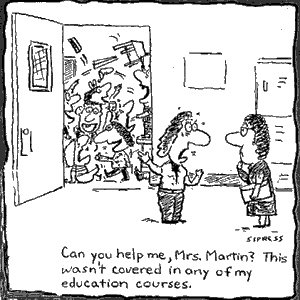 |
| Can you help me, Mrs. Martin? This wasn't covered in any of my education courses. |
I currently teach two sections of English 4 (12th grade). Although both sections generally do their work, things have shifted since they came back from Spring Break. For the past 3 weeks or so, students have become more and more apathetic. They do not want to do their work and express wishes to simply "get by" with whatever minimum requirements will keep them afloat enough so they pass the class. Along with this Senioritis, classroom management has become more of a challenge. These students have been used to my CT's style of classroom management for the past year and I understand that I cannot come in with sudden, dramatic changes halfway through second semester. I have steered away from changing anything too much. Classroom management does prove difficult then, when students see me taking more of a lead role, trying to assert myself, while they are winding down and feel that they are done with high school. Chit chatting, cell phones, homework completion, even in-class work has all of a sudden become more a challenge.
I am thankful to have a CT who is understanding and is not afraid to admit that we are facing a challenge that is difficult to overcome. We have talked to the students, kept them updated on grades, increased the student's level of accountability; we are trying to help them get back on task but also explaining that their next step in life (college for most of the students there) will not have someone pushing your or helping you at all times. In a way, we want to show them the importance of self-reliance and the consequences of not being responsible but we don't want to allow them to flounder and face grave consequences (like not graduating) if they do not take responsibility.
Classroom management was definitely difficult this week. As I plan for next week, I can only hope to continue trying and working with my classes and CT so that the next few weeks of our students' high school careers are enjoyable but also productive.







